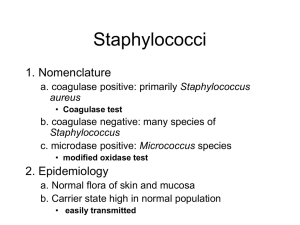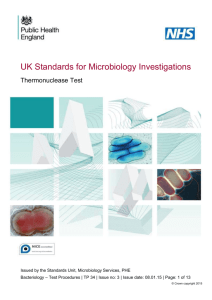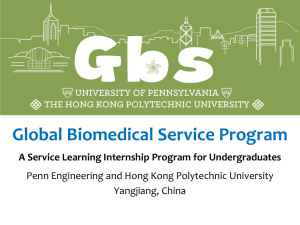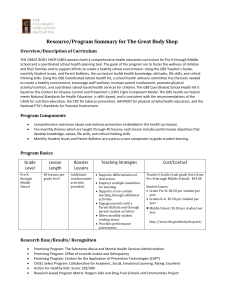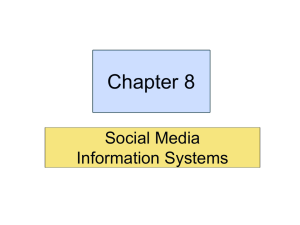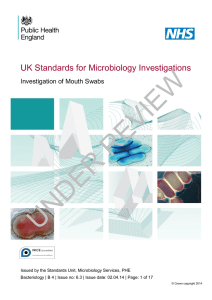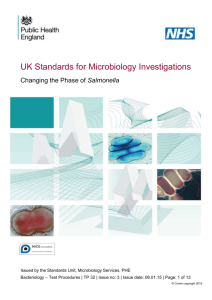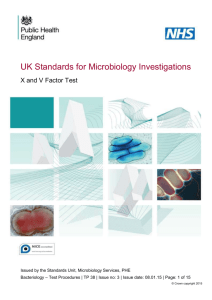B 58i3 June 2015
advertisement
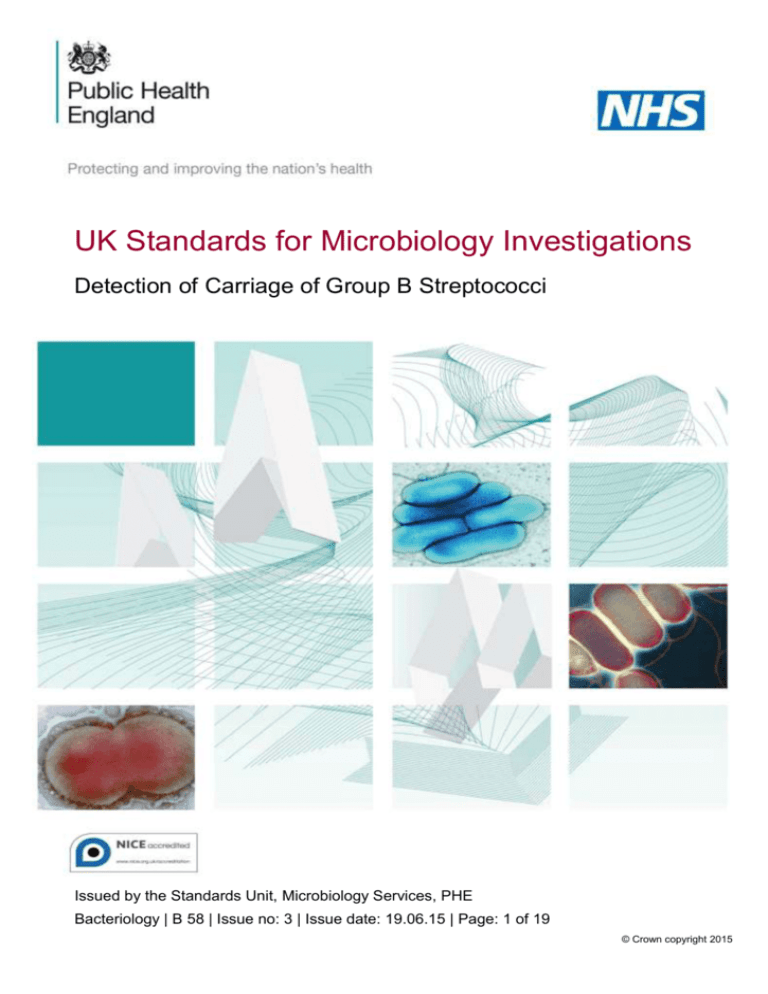
UK Standards for Microbiology Investigations Detection of Carriage of Group B Streptococci Issued by the Standards Unit, Microbiology Services, PHE Bacteriology | B 58 | Issue no: 3 | Issue date: 19.06.15 | Page: 1 of 19 © Crown copyright 2015 Detection of Carriage of Group B Streptococci Acknowledgments UK Standards for Microbiology Investigations (SMIs) are developed under the auspices of Public Health England (PHE) working in partnership with the National Health Service (NHS), Public Health Wales and with the professional organisations whose logos are displayed below and listed on the website https://www.gov.uk/ukstandards-for-microbiology-investigations-smi-quality-and-consistency-in-clinicallaboratories. SMIs are developed, reviewed and revised by various working groups which are overseen by a steering committee (see https://www.gov.uk/government/groups/standards-for-microbiology-investigationssteering-committee). The contributions of many individuals in clinical, specialist and reference laboratories who have provided information and comments during the development of this document are acknowledged. We are grateful to the Medical Editors for editing the medical content. For further information please contact us at: Standards Unit Microbiology Services Public Health England 61 Colindale Avenue London NW9 5EQ E-mail: standards@phe.gov.uk Website: https://www.gov.uk/uk-standards-for-microbiology-investigations-smi-qualityand-consistency-in-clinical-laboratories PHE Publications gateway number: 2015075 UK Standards for Microbiology Investigations are produced in association with: Logos correct at time of publishing. Bacteriology | B 58 | Issue no: 3 | Issue date: 19.06.15 | Page: 2 of 19 UK Standards for Microbiology Investigations | Issued by the Standards Unit, Public Health England Detection of Carriage of Group B Streptococci Contents ACKNOWLEDGMENTS .......................................................................................................... 2 AMENDMENT TABLE ............................................................................................................. 4 UK SMI: SCOPE AND PURPOSE ........................................................................................... 6 SCOPE OF DOCUMENT ......................................................................................................... 8 INTRODUCTION ..................................................................................................................... 8 TECHNICAL INFORMATION/LIMITATIONS ......................................................................... 10 1 SAFETY CONSIDERATIONS .................................................................................... 11 2 SPECIMEN COLLECTION ......................................................................................... 11 3 SPECIMEN TRANSPORT AND STORAGE ............................................................... 12 4 SPECIMEN PROCESSING/PROCEDURE ................................................................. 12 5 REPORTING PROCEDURE ....................................................................................... 14 6 NOTIFICATION TO PHE OR EQUIVALENT IN THE DEVOLVED ADMINISTRATIONS .................................................................................................. 14 APPENDIX: DETECTION OF CARRIAGE OF GROUP B STREPTOCOCCI ........................ 16 REFERENCES ...................................................................................................................... 17 Bacteriology | B 58 | Issue no: 3 | Issue date: 19.06.15 | Page: 3 of 19 UK Standards for Microbiology Investigations | Issued by the Standards Unit, Public Health England Detection of Carriage of Group B Streptococci Amendment table Each SMI method has an individual record of amendments. The current amendments are listed on this page. The amendment history is available from standards@phe.gov.uk. New or revised documents should be controlled within the laboratory in accordance with the local quality management system. Amendment No/Date. 6/19.06.15 Issue no. discarded. 2.3 Insert Issue no. 3 Section(s) involved Amendment Whole document. Hyperlinks updated to gov.uk. Page 2. Updated logos added. Whole document. Emphasis on availability of this GBS detection method for laboratories to undertake when required and does not cut across the UK National Screening Committee recommendation that antenatal screening for GBS colonisation is not recommended. Any mention of screening pregnant women for colonisation of GBS has been removed to minimise ambiguity. Title. The title of the document has been changed from ‘Processing swabs for Group B streptococcal carriage’ to ‘Detection of carriage of Group B streptococci’. Scope. Amended to make the scope and purpose of the document clear. Introduction. Re-structured to present the information clearly. Colonisation. Colonisation of GBS amended from up to 30% to up to 28% and referenced. Infection. Updated. Reference to a 1998 Working Group removed. Method of investigation. Updated. The use of selective agar for sub culture from enrichment broth added. Collection of rectovaginal swabs between 35 and 37 weeks gestation and USA guidelines has been removed. Treatment. The section is outside the scope of the document Bacteriology | B 58 | Issue no: 3 | Issue date: 19.06.15 | Page: 4 of 19 UK Standards for Microbiology Investigations | Issued by the Standards Unit, Public Health England Detection of Carriage of Group B Streptococci and has been removed. Rapid methods. Section added. Specimen collection. Updated for clarity. Type of manufactured swabs covered. Collection of specimens by qualified caregiver or patient added. Culture and investigation. Updated to provide information on culture examination. 4.5.1 Culture media, conditions and organisms. Updated to include options for selective and chromogenic agar for subculture of enrichment broth. Appendix. Flowchart added. References. Updated. Bacteriology | B 58 | Issue no: 3 | Issue date: 19.06.15 | Page: 5 of 19 UK Standards for Microbiology Investigations | Issued by the Standards Unit, Public Health England Detection of Carriage of Group B Streptococci UK SMI: scope and purpose Users of SMIs Primarily, SMIs are intended as a general resource for practising professionals operating in the field of laboratory medicine and infection specialties in the UK. SMIs also provide clinicians with information about the available test repertoire and the standard of laboratory services they should expect for the investigation of infection in their patients, as well as providing information that aids the electronic ordering of appropriate tests. The documents also provide commissioners of healthcare services with the appropriateness and standard of microbiology investigations they should be seeking as part of the clinical and public health care package for their population. Background to SMIs SMIs comprise a collection of recommended algorithms and procedures covering all stages of the investigative process in microbiology from the pre-analytical (clinical syndrome) stage to the analytical (laboratory testing) and post analytical (result interpretation and reporting) stages. Syndromic algorithms are supported by more detailed documents containing advice on the investigation of specific diseases and infections. Guidance notes cover the clinical background, differential diagnosis, and appropriate investigation of particular clinical conditions. Quality guidance notes describe laboratory processes which underpin quality, for example assay validation. Standardisation of the diagnostic process through the application of SMIs helps to assure the equivalence of investigation strategies in different laboratories across the UK and is essential for public health surveillance, research and development activities. Equal partnership working SMIs are developed in equal partnership with PHE, NHS, Royal College of Pathologists and professional societies. The list of participating societies may be found at https://www.gov.uk/uk-standards-for-microbiology-investigations-smi-qualityand-consistency-in-clinical-laboratories. Inclusion of a logo in an SMI indicates participation of the society in equal partnership and support for the objectives and process of preparing SMIs. Nominees of professional societies are members of the Steering Committee and Working Groups which develop SMIs. The views of nominees cannot be rigorously representative of the members of their nominating organisations nor the corporate views of their organisations. Nominees act as a conduit for two way reporting and dialogue. Representative views are sought through the consultation process. SMIs are developed, reviewed and updated through a wide consultation process. Quality assurance NICE has accredited the process used by the SMI Working Groups to produce SMIs. The accreditation is applicable to all guidance produced since October 2009. The process for the development of SMIs is certified to ISO 9001:2008. SMIs represent a good standard of practice to which all clinical and public health microbiology Microbiology is used as a generic term to include the two GMC-recognised specialties of Medical Microbiology (which includes Bacteriology, Mycology and Parasitology) and Medical Virology. Bacteriology | B 58 | Issue no: 3 | Issue date: 19.06.15 | Page: 6 of 19 UK Standards for Microbiology Investigations | Issued by the Standards Unit, Public Health England Detection of Carriage of Group B Streptococci laboratories in the UK are expected to work. SMIs are NICE accredited and represent neither minimum standards of practice nor the highest level of complex laboratory investigation possible. In using SMIs, laboratories should take account of local requirements and undertake additional investigations where appropriate. SMIs help laboratories to meet accreditation requirements by promoting high quality practices which are auditable. SMIs also provide a reference point for method development. The performance of SMIs depends on competent staff and appropriate quality reagents and equipment. Laboratories should ensure that all commercial and in-house tests have been validated and shown to be fit for purpose. Laboratories should participate in external quality assessment schemes and undertake relevant internal quality control procedures. Patient and public involvement The SMI Working Groups are committed to patient and public involvement in the development of SMIs. By involving the public, health professionals, scientists and voluntary organisations the resulting SMI will be robust and meet the needs of the user. An opportunity is given to members of the public to contribute to consultations through our open access website. Information governance and equality PHE is a Caldicott compliant organisation. It seeks to take every possible precaution to prevent unauthorised disclosure of patient details and to ensure that patient-related records are kept under secure conditions. The development of SMIs are subject to PHE Equality objectives https://www.gov.uk/government/organisations/public-healthengland/about/equality-and-diversity. The SMI Working Groups are committed to achieving the equality objectives by effective consultation with members of the public, partners, stakeholders and specialist interest groups. Legal statement Whilst every care has been taken in the preparation of SMIs, PHE and any supporting organisation, shall, to the greatest extent possible under any applicable law, exclude liability for all losses, costs, claims, damages or expenses arising out of or connected with the use of an SMI or any information contained therein. If alterations are made to an SMI, it must be made clear where and by whom such changes have been made. The evidence base and microbial taxonomy for the SMI is as complete as possible at the time of issue. Any omissions and new material will be considered at the next review. These standards can only be superseded by revisions of the standard, legislative action, or by NICE accredited guidance. SMIs are Crown copyright which should be acknowledged where appropriate. Suggested citation for this document Public Health England. (2015). Detection of Carriage of Group B Streptococci. UK Standards for Microbiology Investigations. B 58 Issue 3. https://www.gov.uk/ukstandards-for-microbiology-investigations-smi-quality-and-consistency-in-clinicallaboratories Bacteriology | B 58 | Issue no: 3 | Issue date: 19.06.15 | Page: 7 of 19 UK Standards for Microbiology Investigations | Issued by the Standards Unit, Public Health England Detection of Carriage of Group B Streptococci Scope of document Type of specimen Vaginal and rectal swabs Scope The method describes the examination of specimens to detect carriage of Group B streptococci (GBS). This method may also be of value to support research projects investigating GBS carriage. The recommendations within the SMI recognise the current policy from the Royal College of Obstetricians and Gynaecologists 2012, UK National Screening Committee 2012, National Institute for Health and Care Excellence and Public Health England stating that antenatal screening using bacteriological culture or near patient testing techniques should not be introduced in UK practice1-5. The SMI does not seek to contradict these recommendations. This SMI should be used in conjunction with other SMIs. Introduction Lancefield group B streptococci Lancefield Group B streptococci, or Streptococcus agalactiae, are oxidase negative, catalase negative Gram positive cocci occurring in chains. GBS are facultative anaerobes that are serologically classified on the basis of cell wall polysaccharide antigens. On blood agar, the species exhibit -haemolysis, although a very small proportion of strains are non-haemolytic. This can be used as an early step in identifying clinical isolates. After 18-24 hours incubation at 35-37°C colonies tend to be slightly larger than other streptococci (approximately 1mm) and have a less distinct zone of -haemolysis (see ID 4 – Identification of Streptococcus species, Enterococcus species and morphologically similar organisms). Colonisation GBS normally colonises the vagina in many women and the intestines of men and women. Up to 28% of women in the UK carry GBS in the vagina or rectum without any associated symptoms6-8. The gastrointestinal tract is the human reservoir for GBS and the likely source of vaginal colonisation9. Infection Although GBS colonisation is not normally associated with disease in non-pregnant women, GBS can cause infection including bacteraemia in pregnant women9. GBS may cause potentially devastating early onset disease primarily in newborns as well as infections in pregnant women and adults. In pregnancy this organism can infect the amniotic fluid (see B 26 – Investigation of fluids from normally sterile sites) which can lead to neonatal sepsis, pneumonia or meningitis10. In pregnant women, GBS infection is known to cause urinary tract infection, amnionitis, endometritis and wound infection. In men and non-pregnant women, skin or soft tissue infection, bacteraemia, genitourinary infection, balanitis (in men) and pneumonia are the most common manifestations of disease 11,12. Bacteriology | B 58 | Issue no: 3 | Issue date: 19.06.15 | Page: 8 of 19 UK Standards for Microbiology Investigations | Issued by the Standards Unit, Public Health England Detection of Carriage of Group B Streptococci Neonatal infection refers to infection occurring during the first four weeks of life. Infection may be superficial and localised (eg conjunctivitis, pustules, skin infection), deep and localised (pneumonia, septic arthritis, meningitis) or systemic (septicaemia). Presentation differs according to age at onset: early onset disease is more likely than late onset to present with generalised sepsis13. The British Paediatric Surveillance Unit (BPSU) study covering the period February 2000 to February 2001 showed an incidence of early onset GBS of 0.48 cases per 1000 live births and a mortality rate of 9.7%13. The predominant GBS serotypes were III, Ia and V14. The incidence of infection also increases with low birth weight or prematurity and may be divided into: Early onset (0-6 days) - this occurs in the first six days (usually within 48 hours) of life and is caused by infection ascending from the maternal genital tract or, very rarely, via the placenta. Only a small percentage of infants colonised with this organism develop early onset disease. Early infections tend to be associated with pneumonia and septicaemia and may be confused with respiratory distress syndrome Late onset (7-90 days) - this occurs after the first six days (7-90 days) and is associated with acquisition of the organism through vertical or nosocomial transmission or from the external (eg hospital) environment. GBS initially colonise the superficial sites and upper respiratory tract and progress to cause widespread sepsis. Late infection is more likely to be associated with meningitis In the UK, antenatal screening for GBS colonisation is currently not recommended 1-5. Method of investigation The isolation rate of GBS from clinical specimens depends on several factors. Studies have shown that detection for GBS colonisation can be improved by attention to the timing of cultures, the sites swabbed and the microbiological method used for culture of organisms. In 2002, updated guidelines were published by Centers for Disease Control and Prevention that suggested optimum yield will be achieved by selective enrichment procedures applied to swabs obtained from the vagina and the anorectum which increases the likelihood of GBS isolation compared with vaginal or cervical culture alone15. Recto-vaginal swabs are likely to isolate a diverse array of normal flora and use of selective enrichment broth is recommended to avoid overgrowth of other organisms15. After collection, swabs should be placed in a non-nutrient transport medium such as Amies or Stuart. The use of a selective enrichment broth that inhibits the growth of competing organisms such as Gram negative enteric bacilli and other normal flora significantly increases the yield of GBS culture and is recommended since it has been found to be the most sensitive method to detect female colonisation15,16. The most widely used selective enrichment broth is Todd-Hewitt broth with nalidixic acid and colistin (eg Lim broth) or nalidixic acid and gentamicin further sub-cultured on blood agar plate. Several options are available for sub culture of a selective enrichment broth for isolation of GBS including selective and chromogenic agar. Some studies have shown sub culture from selective enrichment broth to selective or chromogenic agar to be equivalent to sub culture to blood agar for GBS isolation16,17. Bacteriology | B 58 | Issue no: 3 | Issue date: 19.06.15 | Page: 9 of 19 UK Standards for Microbiology Investigations | Issued by the Standards Unit, Public Health England Detection of Carriage of Group B Streptococci However, chromogenic media are not fully specific, so all presumptive colonies of GBS should be confirmed by a specific antigenic detection test18. Rapid methods A variety of rapid identification methods are available to detect GBS colonisation in pregnant women directly from vagino-rectal swabs including immunology assays, DNA hybridisation and PCR methods. However, the assays generally have low sensitivity for direct detection and identification of GBS direct from clinical specimens compared to the culture method. Nucleic acid testing assays are found to either take too long or require complicated procedures that are not applicable for clinical use9,19. For presumptive isolates of GBS a variety of rapid identification methods are available with high sensitivity and specificity including PCR and Matrix Assisted Laser Desorption Ionisation Time-of-Flight (MALDI-TOF)20,21. Refer to ID 4 - Identification of Streptococcus species, Enterococcus species and morphologically similar organisms for the identification of GBS. Technical information/limitations Limitations of UK SMIs The recommendations made in UK SMIs are based on evidence (eg sensitivity and specificity) where available, expert opinion and pragmatism, with consideration also being given to available resources. Laboratories should take account of local requirements and undertake additional investigations where appropriate. Prior to use, laboratories should ensure that all commercial and in-house tests have been validated and are fit for purpose. Selective media in screening procedures Selective media which does not support the growth of all circulating strains of organisms may be recommended based on the evidence available. A balance therefore must be sought between available evidence, and available resources required if more than one media plate is used. Specimen containers22,23 SMIs use the term “CE marked leak proof container” to describe containers bearing the CE marking used for the collection and transport of clinical specimens. The requirements for specimen containers are given in the EU in vitro Diagnostic Medical Devices Directive (98/79/EC Annex 1 B 2.1) which states: “The design must allow easy handling and, where necessary, reduce as far as possible contamination of, and leakage from, the device during use and, in the case of specimen receptacles, the risk of contamination of the specimen. The manufacturing processes must be appropriate for these purposes”. Bacteriology | B 58 | Issue no: 3 | Issue date: 19.06.15 | Page: 10 of 19 UK Standards for Microbiology Investigations | Issued by the Standards Unit, Public Health England Detection of Carriage of Group B Streptococci 1 Safety considerations22-38 1.1 Specimen collection, transport and storage22-27 Use aseptic technique. Collect swabs into appropriate transport medium and transport in sealed plastic bags. Compliance with postal, transport and storage regulations is essential. 1.2 Specimen processing22-38 Containment Level 2. Laboratory procedures that give rise to infectious aerosols must be conducted in a microbiological safety cabinet30. Refer to current guidance on the safe handling of all organisms documented in this SMI. The above guidance should be supplemented with local COSHH and risk assessments. 2 Specimen collection 2.1 Type of specimens Low vaginal and rectal swabs. High vaginal swabs should not be collected as these have a lower sensitivity. 2.2 Optimal time and method of collection39 For safety considerations refer to Section 1.1. Collect specimens before antimicrobial therapy where possible39. Unless otherwise stated, swabs for bacterial and fungal culture should then be placed in appropriate transport medium40-44. Rayon or Dacron, Fibre or Flocked swabs, with non nutritive transport media (eg Amies or Stuart’s), preserve the viability of the organism by providing moisture, and buffering to maintain the pH. Specimen(s) for culture may be collected either by the physician or other qualified caregiver (or may be self-collected by the patient, with appropriate instruction). This involves swabbing the distal vagina (vaginal introitus), followed by the rectum. A single swab for both sites of collection is rational but two different swabs can be used. Because lower vaginal as opposed to cervical cultures are recommended, cultures should not be collected by speculum examination. 2.3 Adequate quantity and appropriate number of specimens39 One combined vaginal/rectal swab or two separate swabs processed as one. Numbers and frequency of specimen collection are dependent on clinical condition of patient. Bacteriology | B 58 | Issue no: 3 | Issue date: 19.06.15 | Page: 11 of 19 UK Standards for Microbiology Investigations | Issued by the Standards Unit, Public Health England Detection of Carriage of Group B Streptococci 3 Specimen transport and storage22,23 3.1 Optimal transport and storage conditions For safety considerations refer to Section 1.1. Specimens should be transported and processed as soon as possible 39. If processing is delayed, refrigeration is preferable to storage at ambient temperature39. 4 Specimen processing/procedure22,23 4.1 Test selection N/A 4.2 Appearance N/A 4.3 Sample preparation For safety considerations refer to Section 1.2. 4.4 Microscopy N/A 4.5 Culture and investigation Selective enrichment culture Remove the cap aseptically from the container and place the swab(s) in the LIMs broth, break off (or cut) the swab stick(s) and replace the cap. Caps should be kept loose during incubation. Culture After an overnight incubation at 35-37°C, 5% CO2, sub-culture with a sterile loop and inoculate appropriate media (see table 4.5.1). Optimum detection of GBS may require the use of more than one culture medium. For the isolation of individual colonies, spread inoculum with a sterile loop. Incubate the plate(s) at 35 to 37°C in the appropriate atmosphere for 24-48hr. Culture examination After an overnight incubation, observe plates for suggestive GBS colonies and identify them. If negative after overnight incubation, re-incubate an additional 24 hours before reporting a negative result. On blood agar, suggestive colonies of GBS are grey, translucent, with a surrounding zone of beta-hemolysis (or no hemolysis: very rare). Refer to manufacturer’s instructions for GBS detection on selective and chromogenic agar. Bacteriology | B 58 | Issue no: 3 | Issue date: 19.06.15 | Page: 12 of 19 UK Standards for Microbiology Investigations | Issued by the Standards Unit, Public Health England Detection of Carriage of Group B Streptococci 4.5.1 Culture media, conditions and organisms Clinical details/ Specimen Standard media Incubation Conditions Carriage of Group B streptococci Low vaginal and rectal swabs LIM Broth (5mL)†: ToddHewitt broth supplemented with 10µg/mL colistin and 15µg/mL nalidixic acid) Then subculture to: Cultures read Temp °C Atmos Time 35-37 5% CO2 18-24hr N/A 35-37 5% CO2 24-48hr 18-24hr and Blood agar Target organism(s) Group B streptococci 48hr or Selective agar 35-37 Ambient 24-48hr 18-24hr 35-37 Ambient 24-48hr 18-24hr or Chromogenic agar †The bottle should contain a volume of broth sufficient to cover the swabs 4.6 Identification Refer to ID 4 - Identification of Streptococcus species, Enterococcus species and morphologically similar organisms for the identification of GBS. 4.6.1 Minimum level of identification in the laboratory Streptococcus agalactiae species level Organisms may be further identified if this is clinically or epidemiologically indicated. 4.7 Antimicrobial susceptibility testing Refer to British Society for Antimicrobial Chemotherapy (BSAC) and/or EUCAST guidelines. Prudent use of antimicrobials according to local and national protocols is recommended. 4.8 Referral for outbreak investigations N/A 4.9 Referral to reference laboratories For information on the tests offered, turn around times, transport procedure and the other requirements of the reference laboratory click here for user manuals and request forms. Bacteriology | B 58 | Issue no: 3 | Issue date: 19.06.15 | Page: 13 of 19 UK Standards for Microbiology Investigations | Issued by the Standards Unit, Public Health England Detection of Carriage of Group B Streptococci Organisms with unusual or unexpected resistance, and whenever there is a laboratory or clinical problem, or anomaly that requires elucidation should be sent to the appropriate reference laboratory. Contact appropriate devolved national reference laboratory for information on the tests available, turn around times, transport procedure and any other requirements for sample submission: England and Wales https://www.gov.uk/specialist-and-reference-microbiology-laboratory-tests-andservices Scotland http://www.hps.scot.nhs.uk/reflab/index.aspx Northern Ireland http://www.publichealth.hscni.net/directorate-public-health/health-protection 5 Reporting procedure 5.1 Microscopy N/A 5.2 Culture Report: Negatives “Group B streptococci not isolated” Positives “Group B streptococci isolated” 5.2.1 Culture reporting time Clinically urgent results: to be telephoned or sent electronically. Written report: 16 – 72hr stating, if appropriate, that a further report will be issued. 5.3 Antimicrobial susceptibility testing Report susceptibilities as clinically indicated. Prudent use of antimicrobials according to local and national protocols is recommended. 6 Notification to PHE45,46 or equivalent in the devolved administrations47-50 The Health Protection (Notification) regulations 2010 require diagnostic laboratories to notify Public Health England (PHE) when they identify the causative agents that are listed in Schedule 2 of the Regulations. Notifications must be provided in writing, on paper or electronically, within seven days. Urgent cases should be notified orally and as soon as possible, recommended within 24 hours. These should be followed up by written notification within seven days. Bacteriology | B 58 | Issue no: 3 | Issue date: 19.06.15 | Page: 14 of 19 UK Standards for Microbiology Investigations | Issued by the Standards Unit, Public Health England Detection of Carriage of Group B Streptococci For the purposes of the Notification Regulations, the recipient of laboratory notifications is the local PHE Health Protection Team. If a case has already been notified by a registered medical practitioner, the diagnostic laboratory is still required to notify the case if they identify any evidence of an infection caused by a notifiable causative agent. Notification under the Health Protection (Notification) Regulations 2010 does not replace voluntary reporting to PHE. The vast majority of NHS laboratories voluntarily report a wide range of laboratory diagnoses of causative agents to PHE and many PHE Health protection Teams have agreements with local laboratories for urgent reporting of some infections. This should continue. Note: The Health Protection Legislation Guidance (2010) includes reporting of Human Immunodeficiency Virus (HIV) & Sexually Transmitted Infections (STIs), Healthcare Associated Infections (HCAIs) and Creutzfeldt–Jakob disease (CJD) under ‘Notification Duties of Registered Medical Practitioners’: it is not noted under ‘Notification Duties of Diagnostic Laboratories’. https://www.gov.uk/government/organisations/public-health-england/about/ourgovernance#health-protection-regulations-2010 Other arrangements exist in Scotland47,48, Wales49 and Northern Ireland50. Bacteriology | B 58 | Issue no: 3 | Issue date: 19.06.15 | Page: 15 of 19 UK Standards for Microbiology Investigations | Issued by the Standards Unit, Public Health England Detection of Carriage of Group B Streptococci Appendix: Detection of carriage of group B streptococci Collect specimens LIM Broth (5mL Todd-Hewitt broth supplemented with 10µg/mL colistin and 15µg/mL nalidixic acid) Incubate at 35-37°C, 5-10% CO2 18-24hr Subculture to blood agar, selective or chromogenic agar Incubate at 35-37°C in the appropriate atmosphere for 24-48hr read at 18-24hr ID 4 - Confirm identification of Group B Streptococci Bacteriology | B 58 | Issue no: 3 | Issue date: 19.06.15 | Page: 16 of 19 UK Standards for Microbiology Investigations | Issued by the Standards Unit, Public Health England Detection of Carriage of Group B Streptococci References 1. Public Health England. Enriched culture medium testing for group B streptococcus is not recommended within current clinical guidance: a briefing note from PHE. 2014. 2. Royal College of Obstetricians and Gynaecologists. Prevention of early onset neonatal Group B Streptococcal disease. 2012. 3. UK National Screening Committee. Screening for Group B Streptococcal infection in pregnancy. 2012. 4. UK National Screening Committee. Antenatal Screening for Group B Streptococcus Policy Position Statement. 2012. 5. National Institute for Health and Clinical Excellence. Antenatal care. 2010. 6. Hastings MJ, Easmon CS, Neill J, Bloxham B, Rivers RP. Group B streptococcal colonisation and the outcome of pregnancy. J Infect 1986;12:23-9. 7. Jones N, Oliver K, Jones Y, Haines A, Crook D. Carriage of group B streptococcus in pregnant women from Oxford, UK. J Clin Pathol 2006;59:363-6. 8. Hassan IA, Onon TS, Weston D, Isalska B, Wall K, Afshar B, et al. A quantitative descriptive study of the prevalence of carriage (colonisation) of haemolytic streptococci groups A, B, C and G in pregnancy. J Obstet Gynaecol 2011;31:207-9. 9. Picard FJ, Bergeron MG. Laboratory detection of group B Streptococcus for prevention of perinatal disease. Eur J Clin Microbiol Infect Dis 2004;23:665-71. 10. Hanley J. Neonatal infections: group B streptococcus. Clin Evid (Online ) 2008;2008. 11. Farley MM, Harvey RC, Stull T, Smith JD, Schuchat A, Wenger JD, et al. A population-based assessment of invasive disease due to group B streptococcus in nonpregnant adults. N Engl J Med 1993;328:1807-11. 12. Lucks DA, Venezio FR, Lakin CM. Balanitis caused by group B streptococcus. J Urol 1986;135:1015. 13. Heath PT, Balfour G, Weisner AM, Efstratiou A, Lamagni TL, Tighe H, et al. Group B streptococcal disease in UK and Irish infants younger than 90 days. Lancet 2004;363:292-4. 14. Weisner AM, Johnson AP, Lamagni TL, Arnold E, Warner M, Heath PT, et al. Characterization of group B streptococci recovered from infants with invasive disease in England and Wales. Clin Infect Dis 2004;38:1203-8. 15. Schrag S, Gorwitz R, Fultz-Butts K, Schuchat A. Prevention of perinatal group B streptococcal disease. Revised guidelines from CDC. MMWR Recomm Rep 2002;51:1-22. 16. Gupta C, Briski LE. Comparison of two culture media and three sampling techniques for sensitive and rapid screening of vaginal colonization by group B streptococcus in pregnant women. J Clin Microbiol 2004;42:3975-7. 17. El Aila NA, Tency I, Claeys G, Saerens B, Cools P, Verstraelen H, et al. Comparison of different sampling techniques and of different culture methods for detection of group B streptococcus carriage in pregnant women. BMC Infect Dis 2010;10:285. Bacteriology | B 58 | Issue no: 3 | Issue date: 19.06.15 | Page: 17 of 19 UK Standards for Microbiology Investigations | Issued by the Standards Unit, Public Health England Detection of Carriage of Group B Streptococci 18. Verhoeven PO, Noyel P, Bonneau J, Carricajo A, Fonsale N, Ros A, et al. Evaluation of the new brilliance GBS chromogenic medium for screening of Streptococcus agalactiae vaginal colonization in pregnant women. J Clin Microbiol 2014;52:991-3. 19. Honest H, Sharma S, Khan KS. Rapid Tests for Group B Streptococcus Colonization in Laboring Women: A Systematic Review. Pediatrics 2006;117:1055-66. 20. Daniels JP, Gray J, Pattison HM, Gray R, Hills RK, Khan KS, et al. Intrapartum tests for group B streptococcus: accuracy and acceptability of screening. BJOG: An International Journal of Obstetrics & Gynaecology 2011;118:257-65. 21. Clark AE, Kaleta EJ, Arora A, Wolk DM. Matrix-assisted laser desorption ionization-time of flight mass spectrometry: a fundamental shift in the routine practice of clinical microbiology. Clin Microbiol Rev 2013;26:547-603. 22. European Parliament. UK Standards for Microbiology Investigations (SMIs) use the term "CE marked leak proof container" to describe containers bearing the CE marking used for the collection and transport of clinical specimens. The requirements for specimen containers are given in the EU in vitro Diagnostic Medical Devices Directive (98/79/EC Annex 1 B 2.1) which states: "The design must allow easy handling and, where necessary, reduce as far as possible contamination of, and leakage from, the device during use and, in the case of specimen receptacles, the risk of contamination of the specimen. The manufacturing processes must be appropriate for these purposes". 23. Official Journal of the European Communities. Directive 98/79/EC of the European Parliament and of the Council of 27 October 1998 on in vitro diagnostic medical devices. 7-12-1998. p. 1-37. 24. Health and Safety Executive. Safe use of pneumatic air tube transport systems for pathology specimens. 9/99. 25. Department for transport. Transport of Infectious Substances, 2011 Revision 5. 2011. 26. World Health Organization. Guidance on regulations for the Transport of Infectious Substances 2013-2014. 2012. 27. Home Office. Anti-terrorism, Crime and Security Act. 2001 (as amended). 28. Advisory Committee on Dangerous Pathogens. The Approved List of Biological Agents. Health and Safety Executive. 2013. p. 1-32 29. Advisory Committee on Dangerous Pathogens. Infections at work: Controlling the risks. Her Majesty's Stationery Office. 2003. 30. Advisory Committee on Dangerous Pathogens. Biological agents: Managing the risks in laboratories and healthcare premises. Health and Safety Executive. 2005. 31. Advisory Committee on Dangerous Pathogens. Biological Agents: Managing the Risks in Laboratories and Healthcare Premises. Appendix 1.2 Transport of Infectious Substances Revision. Health and Safety Executive. 2008. 32. Centers for Disease Control and Prevention. Guidelines for Safe Work Practices in Human and Animal Medical Diagnostic Laboratories. MMWR Surveill Summ 2012;61:1-102. 33. Health and Safety Executive. Control of Substances Hazardous to Health Regulations. The Control of Substances Hazardous to Health Regulations 2002. 5th ed. HSE Books; 2002. 34. Health and Safety Executive. Five Steps to Risk Assessment: A Step by Step Guide to a Safer and Healthier Workplace. HSE Books. 2002. Bacteriology | B 58 | Issue no: 3 | Issue date: 19.06.15 | Page: 18 of 19 UK Standards for Microbiology Investigations | Issued by the Standards Unit, Public Health England Detection of Carriage of Group B Streptococci 35. Health and Safety Executive. A Guide to Risk Assessment Requirements: Common Provisions in Health and Safety Law. HSE Books. 2002. 36. Health Services Advisory Committee. Safe Working and the Prevention of Infection in Clinical Laboratories and Similar Facilities. HSE Books. 2003. 37. British Standards Institution (BSI). BS EN12469 - Biotechnology - performance criteria for microbiological safety cabinets. 2000. 38. British Standards Institution (BSI). BS 5726:2005 - Microbiological safety cabinets. Information to be supplied by the purchaser and to the vendor and to the installer, and siting and use of cabinets. Recommendations and guidance. 24-3-2005. p. 1-14 39. Baron EJ, Miller JM, Weinstein MP, Richter SS, Gilligan PH, Thomson RB, Jr., et al. A Guide to Utilization of the Microbiology Laboratory for Diagnosis of Infectious Diseases: 2013 Recommendations by the Infectious Diseases Society of America (IDSA) and the American Society for Microbiology (ASM). Clin Infect Dis 2013;57:e22-e121. 40. Rishmawi N, Ghneim R, Kattan R, Ghneim R, Zoughbi M, Abu-Diab A, et al. Survival of fastidious and nonfastidious aerobic bacteria in three bacterial transport swab systems. J Clin Microbiol 2007;45:1278-83. 41. Barber S, Lawson PJ, Grove DI. Evaluation of bacteriological transport swabs. Pathology 1998;30:179-82. 42. Van Horn KG, Audette CD, Sebeck D, Tucker KA. Comparison of the Copan ESwab system with two Amies agar swab transport systems for maintenance of microorganism viability. J Clin Microbiol 2008;46:1655-8. 43. Nys S, Vijgen S, Magerman K, Cartuyvels R. Comparison of Copan eSwab with the Copan Venturi Transystem for the quantitative survival of Escherichia coli, Streptococcus agalactiae and Candida albicans. Eur J Clin Microbiol Infect Dis 2010;29:453-6. 44. Tano E, Melhus A. Evaluation of three swab transport systems for the maintenance of clinically important bacteria in simulated mono- and polymicrobial samples. APMIS 2011;119:198-203. 45. Public Health England. Laboratory Reporting to Public Health England: A Guide for Diagnostic Laboratories. 2013. p. 1-37. 46. Department of Health. Health Protection Legislation (England) Guidance. 2010. p. 1-112. 47. Scottish Government. Public Health (Scotland) Act. 2008 (as amended). 48. Scottish Government. Public Health etc. (Scotland) Act 2008. Implementation of Part 2: Notifiable Diseases, Organisms and Health Risk States. 2009. 49. The Welsh Assembly Government. Health Protection Legislation (Wales) Guidance. 2010. 50. Home Office. Public Health Act (Northern Ireland) 1967 Chapter 36. 1967 (as amended). Bacteriology | B 58 | Issue no: 3 | Issue date: 19.06.15 | Page: 19 of 19 UK Standards for Microbiology Investigations | Issued by the Standards Unit, Public Health England

